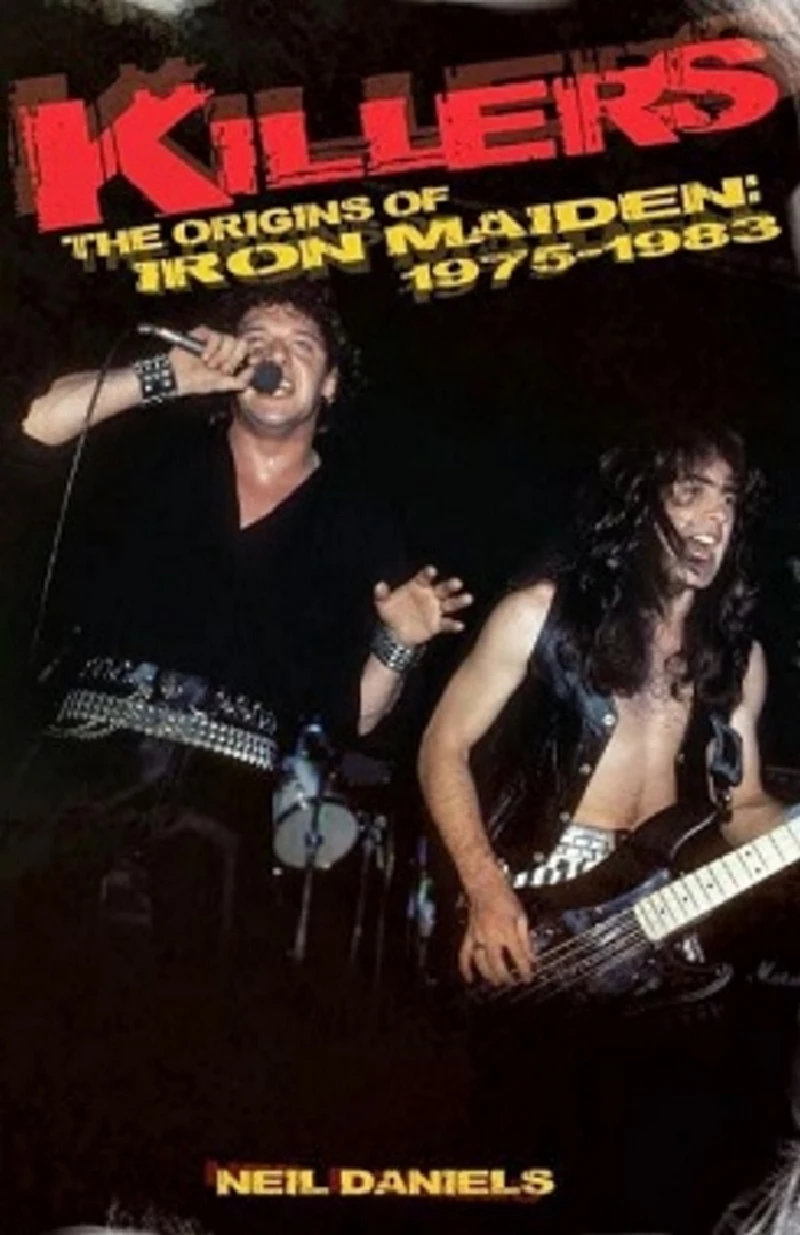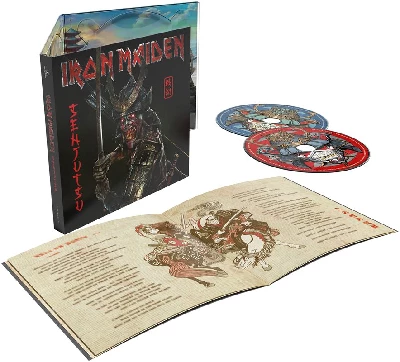Iron Maiden - (Raging Pages) Neil Daniels/Killers: The Origins of Iron Maiden, 1975 - 1983
by Lisa Torem
published: 9 / 7 / 2014

intro
In her book review column 'Raging Pages', Lisa Torem examines Neil Daniels' new biography which examines the early years of heavy metal giants Iron Maiden
It seems only fair that after June’s Raging Pages about Detroit punk that we’re obliged to brand some oozing metal. You may remember that we launched the column with Neil Daniel’s ZZ Top book, 'Hell Raisers and Beer Drinkers', but, as he’s an author whose work defies boundaries, we’re happy to feature Neil once more for an analysis of 'Killers: The Origins of Iron Maiden: 1975-1983'(Soundcheck Books). Although Iron Maiden eventually became one of the most successful heavy metal bands of their time, their formative years were flanked by frequent line-up changes and an ongoing struggle for identity. In Neil Daniel’s book, the acclaimed British author underscores the band’s often rocky ascent through first-person source material, scores of memorabilia, a foreword by Ron Thal (Guns N’ Roses) and an afterword by Tim Owens (ex-Judas Priest vocalist). Photographs by iconic Chicago-based photographer Paul Natkin and compelling, straightforward anecdotes also complement the natural flow. It was British bassist, Steve Harris, who assembled the band in the mid ‘70s and who served as chief songwriter. 'Iron Maiden (1980) and Killer (1981), which featured lead vocals by Paul Di’Anno, and then the Bruce Dickinson gems, 'The Number of the Beast' (1982) and Peace Of Mind' (1983), get a thorough grilling, and, since he eventually departs but then rejoins the band Dickinson's role is particularly paramount and he’s granted a fair portion of face time. His immense love of classic rock and his outsider personality put his persona into perspective. But what happened to his predecessor? In the early 1980s, Paul Di’Anno’s no-shows, addictions and chronic throat problems alarmed Harris so much that he was “dropped from the band” at the end of 1981. Daniel’s reminds us that “the wheels were going to come off sooner or later,” and Di’Anno’s adamant admission that he didn’t like the heavy metal musical direction the band was heading for, at that point, now comes as no surprise - although it’s suggested that the press had a field day chronicling their differences. But Daniels doesn’t stop at the exodus. Di’Anno’s post-Maiden projects, especially his band, Killers, enjoyed a “cult following,” and, like it or not, Di’Anno continued to “give them what they want” in terms of honouring the Maiden catalogue. Daniel’s explains clearly Di’Anno’s “contradictory opinions” – his strong desire to move in another creative direction and his desire to please the fans that stood by him as he rose to success. Maiden’s “Line-Up History’ illustrates that between the aforementioned years there were no less than three lead vocalists, four percussionists and more than seven guitarists - just that statistic alone drums up a myriad of queries and, although much has been written about the band’s latter years, Daniel’s decision to concentrate on this formative era was an intelligent one. Through this “less is more” approach, he gathered numerous humorous and insightful responses from colourful sources, including piercing interviews with former band members. He also pulls from previously published interviews in popular magazines and adverts from classic trades like 'Melody Maker' – this symmetry lends itself to a lively format. The quotes often reflect simpler times, such as when guitarist Dennis Stratton reminisces about listening to a Led Zeppelin tune, “just trying to find the notes” before the age of the internet. The band members have strong musical preferences. Harris hates punk yet its rise and contrast to metal is too important to ignore. Daniels describes the confusion and tension of the era to a tee; name checking the corresponding movers and shakers. At other times, he employs the expertise of American writer Ray Van Horn Jr. to draw astute conclusions about Maiden’s relationship with American roots music. It’s an unexpected digression but a satisfying one. True, Daniels authored an earlier book in 2012, 'Iron Maiden: The Ultimate Unauthorized History Of The Beast' (Voyager Press), so he had already been steeped in their dramatic saga, but that precursor, which is equally comprehensive, remains a stand alone. In one clever section, Bob Nalbandian, of 'Headbanger', recollects being entranced by Maiden via the then groundbreaking MTV in the 1980s – further on, other writers, like Joshua Wood ('Metal-Rules') discuss Canada’s “love affair” with Maiden and label owners. But the downside of touring and sudden fame is given its due, as well: bad food, ill health, chilly and dysfunctional coaches, vocal exhaustion and rivalries with bands like Judas Priest plague the ambitious metal makers – Stratton and prog rocker Harris lock horns when it comes to studio arrangements, but the balanced first-person accounts truly serve to arouse our empathy. Daniels becomes more generous with praise for the band mates as the story unfolds. When the over-prepared Bruce Dickinson auditions with more songs than needed, his enthusiasm and hard work are immediately and greatly acknowledged and he is immediately taken under wing. Harris appreciates the singer’s sense of style and natural vocals – they’re compatible in their visions, they click. But when the pressure of completing a third album develops, new tensions mount. Daniels sits us down in the studio and into the ears of the production team vis a vis a song-by-song mental workout. Despite the pressure, an important transformation takes place – the songwriting becomes a family affair and we’re witness to the collective spirit. This relatively short book is extended and enhanced by a series of appendices: Metal Heads Talk Maiden has a riveting, conversational tone and is a logical extension to the main text. There is a detailed discography, bibliography and “gigs list” and the midsection photos included are varied, muscular and include the Maiden mascot “Eddie”. I recommend this book for raging headbangers and timid wannabees alike. Even a neophyte will come off sounding like an expert after reading Neil Daniel’s well-researched and absorbing analysis of these alluring metal giants. Neil Daniels is co-author of 'Dawn of the Metal Gods, My Life in Judas Priest', has written books about Bon Jovi, Journey, Robert Plant, UFO, ZZ Top and too many other rock and metal bands to mention here. A film devotee, he will soon be publishing a book about American actor Matthew McConaughey. More information can be found at www.neildanielsbooks.com and www.soundcheckbooks.co.uk.
Also In Raging Pages
Alice Cooper (2015)
Beatles (2022)
Benjamin Orr (2018)
Bernard Purdie (2015)
Billy Bragg (2017)
Billy J. Kramer (2016)
Bob Boilen (2016)
Bob Dylan (2018)
Bob Marley (2019)
Brian Wilson (2017)
Byrds (2024)
Carl Ewens (2025)
Cher (2025)
Clive Davis (2015)
Common (2020)
Damned (2021)
Don Short (2020)
Donovan (2022)
Elliott Murphy (2019)
Elvis Costello (2015)
Felix Cavaliere (2022)
Flip Side (2025)
Frank Sinatra (2023)
Frank Zappa (2017)
Gary Wright (2014)
Gene Simmons (2015)
Geoff Emerick (2018)
George Harrison (2022)
Graham Nash (2023)
Green Day (2019)
Holger Czukay (2025)
Ian Mclagan (2016)
Jann Wenner (2019)
Jerry Lee Lewis (2015)
Jerry Nolan (2018)
Jim Summaria and Mark Plotnick (2019)
Jimmy Webb (2022)
Joe Perry (Aerosmith) (2014)
John Lennon (2017)
Kinks (2014)
Lani Hall Alpert (2019)
Laurence Juber (2014)
Liberty DeVitto (2021)
Lisa Robinson (2021)
Lita Ford (2021)
Little Anthony (2014)
Louise Harrison (2015)
Luke Haines (2024)
Manic Street Preachers (2017)
Mary Wilson (2021)
Michael Bloomfield (2020)
Michael Dorf (2019)
Miscellaneous (2014)
Ozzy Osbourne (2014)
Pamela Des Barres (2017)
Paul McCartney (2020)
Radiohead (2022)
Renee Rosen (2018)
Richard Balls (2018)
Rick Wakeman (2023)
Ringo Starr (2015)
Robby Krieger Band (2022)
Roger Daltrey (2020)
Rolling Stones (2016)
Ronnie Wood (2015)
Roy Bond (2023)
Sam Phillips (2018)
Sean Madigan Hoen (2014)
Silas House (2020)
Spencer Vignes (2017)
Spirit (2023)
Suzi Quatro (2023)
Sylvain Sylvain (2018)
Thin Lizzy (2016)
Tommy James (2021)
Tommy Mottola (2025)
Tori Amos (2020)
U2 (2021)
Who (2014)
Will Romano (2015)
Woody Woodmansey (2018)
Zz Top (2014)
Article Links:-
http://www.neildanielsbooks.comhttp://www.soundcheckbooks.co.uk
Band Links:-
https://www.ironmaiden.com/https://www.facebook.com/ironmaiden
https://twitter.com/IronMaiden
Have a Listen:-
soundcloud
reviews |
|
Senjutsu (2021) |

|
| Resilient and dynamic first album in six years from heavy metal giants Iron Maiden |
most viewed articles
current edition
Carl Ewens - David Bowie 1964 to 1982 On Track: Every Album, Every SongArmory Show - Interview with Richard Jobson
John McKay - Interview
Colin Blunstone - Thalia Hall, Chicago, 16/7/2025
Bathers - Photoscapes 1
Billie Eilish - O2 Arena, London, 10/7/2025
Loft - Interview
Visor Fest - Valencia, Spain, 26/9/2025...27/9/2025
Sir Tim Rice - Interview
Robert Forster - Interview
previous editions
Manic Street Preachers - (Gig of a Lifetime) Millennium Stadium, Cardiff, December 1999Heavenly - P.U.N.K. Girl EP
Beautiful South - Ten Songs That Made Me Love...
Peter Perrett - In Dreams Begin Responsibilities Interview Part One
Boomtown Rats - Ten Songs That Made Me Love....
Oasis - Oasis, Earl's Court, London, 1995
Coldplay - Wembley Arena. London, 16/8/2022
Prolapse - Interview
Trudie Myerscough-Harris - Interview
Pixies - Ten Songs That Made Me Love...
most viewed reviews
current edition
Davey Woodward - Mumbo in the JumboSick Man of Europe - The Sick Man of Europe
Lucy Spraggan - Other Sides of the Moon
Amy Macdonald - Is This What You've Been Waiting For?
Suzanne Vega - Flying With Angels
Blueboy - 2
Bush - I Beat Loneliness
Phew, Erika Kobayashi,, Dieter Moebius - Radium Girls
Alice Cooper - The Revenge of Alice Cooper
Cynthia Erivo - I Forgive You
Pennyblackmusic Regular Contributors
Adrian Janes
Amanda J. Window
Andrew Twambley
Anthony Dhanendran
Benjamin Howarth
Cila Warncke
Daniel Cressey
Darren Aston
Dastardly
Dave Goodwin
Denzil Watson
Dominic B. Simpson
Eoghan Lyng
Fiona Hutchings
Harry Sherriff
Helen Tipping
Jamie Rowland
John Clarkson
Julie Cruickshank
Kimberly Bright
Lisa Torem
Maarten Schiethart